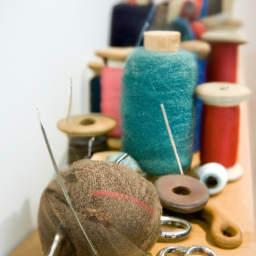
History of Fabric Sewing and Stitching
Fabric sewing and stitching have been integral to human civilization for centuries. The art of joining pieces of fabric together using various techniques has evolved over time, shaping not only the way we dress but also our cultural identities. Let’s delve into the fascinating journey of fabric sewing and stitching throughout history.
Early Beginnings
The origins of fabric sewing and stitching date back to prehistoric times when our ancestors used animal bones or ivory needles to stitch together hides to create garments. Over time, they discovered the versatility of plant fibers, such as flax or hemp, and began weaving and sewing them to form early clothing items.
The ancient Egyptians are renowned for their intricate sewing skills. They used simple tools like thorns or fishbones as needles and spun fibers from plants like cotton and linen into thread. These threads were then carefully stitched into elaborate garments like the iconic pleated linen attire worn by pharaohs and high-ranking officials.
Medieval Period and the Renaissance
During the medieval period, sewing and stitching became elevated to an art form. Embroidery, a technique where decorative stitching is applied to fabric, saw significant advancements. Skilled artisans adorned fabrics with intricate patterns, often using gold and silver threads, precious gemstones, and pearls. These embroidered fabrics were highly sought after by royalty and the nobility.
The Renaissance brought a renewed interest in fashion and luxury, leading to the establishment of professional tailors and dressmakers. With the introduction of more advanced tools like steel needles and scissors, along with improved sewing techniques, clothing became a symbol of social status and wealth.
Industrial Revolution and Modern Times
The Industrial Revolution in the 18th and 19th centuries marked a significant turning point for fabric sewing and stitching. The invention of the sewing machine by Thomas Saint in 1790 revolutionized the industry and made mass production of clothing possible. This advancement in technology drastically reduced the time required to produce garments, allowing for faster and more affordable fashion.
As the 20th century progressed, industrial sewing machines became more advanced and automated, further streamlining the garment production process. The development of synthetic fibers like nylon and polyester provided new materials for stitching, while innovations like computerized embroidery machines opened up endless design possibilities.
Contemporary Sewing and Stitching
Today, fabric sewing and stitching have become a popular craft and hobby, not limited to professionals. Sewing machines are a staple in households, allowing individuals to create unique clothing, accessories, and home decor items. Online communities, tutorials, and patterns have also made it easier for beginners to learn and improve their sewing skills.
Additionally, sustainability and slow fashion movements have rekindled an interest in traditional sewing and stitching techniques. Upcycling old garments, repurposing fabrics, and hand stitching are now embraced as ways to reduce waste and give clothing a new lease of life.
In conclusion, the history of fabric sewing and stitching is a testament to human creativity and adaptability. From primitive hand-stitching to automated machines, this craft has flourished through the ages and continues to inspire and bring beauty to our lives today.




